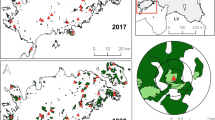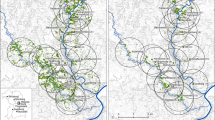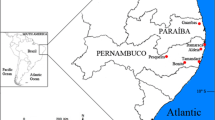Abstract
The impact of temporal changes in habitat availability and land use on the present genetic diversity of the grassland katydid species Metrioptera roeselii was investigated in an extensively used agricultural landscape (Lahn-Dill-Bergland, Germany) based on six microsatellite loci. By integrating spatial and temporal dimensions, this study contrasts to conventional approaches that usually record landscape changes at discrete points in time. Molecular data suggest little geographical substructuring of the species. Nevertheless, time-dependent effects on genetic diversity in terms of observed heterozygosity and allelic richness within subpopulations were detected by general linear models (GLM), explaining up to 82 and 13%, respectively. The results indicated that allelic richness was significantly reduced with higher rates of land-use change. Contrastingly, the level of heterozygosity even increased with increasing land-use change, if this rate increase was accompanied by a reduction in grassland amount, while with an increase of grassland amount the level of heterozygosity remained similar. Furthermore, depending on the study site, heterozygosity was differently affected by grassland age of sampled patches and of the surrounding. This is presumably induced by contrasting levels of heterozygosity in combination with differing modes of dispersal due to habitat availability and site-specific matrix effects. The loss of genetic diversity due to frequent land-use change might result in a reduced ability to adapt to landscape change, which is even more relevant in intensively used agricultural landscapes and in the course of climate change.



Similar content being viewed by others
References
Baessler C, Klotz S (2006) Effects of changes in agricultural land-use on landscape structure and arable weed vegetation over the last 50 years. Agric Ecosyst Environ 115:43–50. doi:10.1016/j.agee.2005.12.007
Baucom RS, Estill JC, Cruzan MB (2005) The effect of deforestation on the genetic diversity and structure in Acer saccharum (Marsh): evidence for the loss and restructuring of genetic variation in a natural system. Conserv Genet 6:39–50. doi:10.1007/s10592-004-7718-9
Belkhir K, Borsa P, Chikhi L, Raufaste N, Bonhomme F (1996–2004) GENETIX 4.05, logiciel sous Windows TM pour la génétique des populations. Laboratoire génome, populations, interactions, CNRS UMR 5000, Université de Montpellier II, Montpellier (France)
Berggren Å, Carlson A, Kindvall O (2001) The effect of landscape composition on colonization success, growth rate and dispersal in introduced bush-crickets Metrioptera roeseli. J Anim Ecol 70:663–670. doi:10.1046/j.1365-2656.2001.00525.x
Berggren Å, Birath B, Kindvall O (2002) Effect of corridors and habitat edges on dispersal behavior, movement rates, and movement angles in Roesel’s bush-cricket (Metrioptera roeseli). Conserv Biol 16:1562–1569. doi:10.1046/j.1523-1739.2002.01203.x
Black WC, Krafsur ES (1985) A FORTRAN program for the calculation and analysis of two-locus linkage disequilibrium coefficients. Theor Appl Genet 70:491–496. doi:10.1007/BF00305981
Burel F (1992) Effect of landscape structure and dynamics on species diversity in hedgerow networks. Landsc Ecol 6:161–174. doi:10.1007/BF00130028
Burel F, Baudry J (2005) Habitat quality and connectivity in agricultural landscapes: the role of land use systems at various scales in time. Ecol Indic 5:305–313. doi:10.1016/j.ecolind.2005.04.002
Chakraborty R, Smouse PE, Neel JV (1988) Population amalgamation and genetic variation: observations on artificially agglomerated tribal populations of Central and South America. Am J Hum Genet 43:709–725
Ernoult A, Freire-Diaz S, Langlois E, Alard D (2006) Are similar landscapes the result of similar histories? Landsc Ecol 21:631–639. doi:10.1007/s10980-005-5321-1
Fahrig L, Jonsen I (1998) Effect of habitat patch characteristics on abundance and diversity of insects in an agricultural landscape. Ecosystems (NY, Print) 1:197–205. doi:10.1007/s100219900015
Fuhr-Bossdorf K, Waldhardt R, Otte A (1999) Effects of land-use dynamics (1945–1998) on the potential of plant communities and species in a marginal cultural landscape. In: Verhandlungen der Gesellschaft für Ökologie, vol 29, pp. 519–530
Gibbs JP (2001) Demography versus habitat fragmentation as determinants of genetic variation in wild populations. Biol Conserv 100:15–20. doi:10.1016/S0006-3207(00)00203-2
Goudet J (2002) Fstat, a program to estimate and test gene diversities and fixation indices (version 2.9.3.2). (Updated from Goudet, J (1995): Fstat (version 1.2): a computer program to calculate F-statistics. J Hered 86:485–486.). Available from http://www.unil.ch/izea/softwares/fstat.html
Haag CR, Riek M, Hottinger JW, Pajunen VI, Ebert D (2005) Genetic diversity and genetic differentiation in Daphnia metapopulations with subpopulations of known age. Genetics 170:1809–1820. doi:10.1534/genetics.104.036814
Hedrick PW (1999) Perspective: highly variable loci and their in interpretation in evolution and conservation. Evol Int J Org Evol 53:313–318. doi:10.2307/2640768
Herben TS, Münzbergová Z, Mildén M, Ehrlén J, Cousins SAO, Eriksson O (2006) Long-term spatial dynamics of Succisa pratensis in a changing rural landscape: linking dynamical modeling with historical maps. J Ecol 94:131–143. doi:10.1111/j.1365-2745.2005.01063.x
Hietel E, Waldhardt R, Otte A (2004) Analysing land-cover changes in relation to environmental variables in Hesse, Germany. Landsc Ecol 19:473–489. doi:10.1023/B:LAND.0000036138.82213.80
Holzhauer SIJ, Wolff K (2005) Polymorphic microsatellite loci in the bush-cricket Metrioptera roeseli. Mol Ecol Notes 5:502–503. doi:10.1111/j.1471-8286.2005.00970.x
Holzhauer SIJ, Sander A-C, Dauber J, Wolters V (2006) The genetic structure of the bush-cricket Metrioptera roeseli is impacted by historical changes in landscape structure. Landsc Ecol 21:891–899. doi:10.1007/s10980-005-0438-9
Ingrisch S (1986) The plurennial life cycles of the European Tettigoniidae (Insecta: Orthoptera), 1. The effect of temperature in embryonic development and hatching. Oecologia 70:606–616. doi:10.1007/BF00379913
Ingrisch S, Köhler G (1998) Die Heuschrecken Mitteleuropas. Neue Brehm-Bücherei, vol 629. Westarp Wissenschaften, Magdeburg
Jacquemyn H, Honnay O, Galbusera P, Roldán-Ruiz I (2004) Genetic structure of the forest herb Primula elatior in a changing landscape. Mol Ecol 13:211–219. doi:10.1046/j.1365-294X.2003.02033.x
Jacquemyn H, Honnay O, Van Looy K, Breyne P (2006) Spatiotemporal structure of genetic variation of a spreading plant metapopulation on dynamic riverbanks along the Meuse River. Heredity 96:471–478. doi:10.1038/sj.hdy.6800825
Kindvall O, Vessby K, Berggren Å, Hartman G (1998) Individual mobility prevents an Allee effect in sparse populations of the bush-cricket Metrioptera roeseli: an experimental study. Oikos 81:449–457. doi:10.2307/3546766
Laußmann H (1999) Die mitteleuropäische Agrarlandschaft als Lebensraum für Heuschrecken (Orthoptera: Saltatoria). Agrarökologie, vol 34. Verlag Agrarökologie, Bern, Hannover
Lindborg R, Eriksson O (2004) Historical landscape connectivity affects present plant species diversity. Ecology 85:1840–1845. doi:10.1890/04-0367
Luikart G, Cornuet JM (1998) Empirical evaluation of a test for identifying recently bottlenecked populations from allele frequency data. Conserv Biol 12:228–237. doi:10.1046/j.1523-1739.1998.96388.x
Marshall JA, Haes ECM (1988) Grasshoppers and allied insects of Great Britain and Ireland. Hartley Books, Colchester
Nei M (1978) Estimation of average heterozygosity and genetic distance from a small number of individuals. Genetics 89:583–590
Nei M (1987) Molecular evolutionary genetics. Columbia University Press, New York
Pannell JR, Charlesworth B (1999) Neutral genetic diversity in a metapopulation with recurrent local extinction and recolonization. Evol Int J Org Evol 53:664–676. doi:10.2307/2640708
Pannell JR, Charlesworth B (2000) Effects of metapopulation processes on measures of genetic diversity. Philos Trans R Soc Lond B Biol Sci 355:1851–1864. doi:10.1098/rstb.2000.0740
Petit S, Burel F (1999) Effect of landscape dynamics on the metapopulation of a ground beetle (Coleoptera, Carabidae) in a hedgerow network. Agric Ecosyst Environ 69:243–252. doi:10.1016/S0167-8809(98)00111-X
Pritchard JK, Stephens M, Donelly P (2000) Inference of population substructure using multilocus genotype. Genetics 155:945–959
Pritchard JK, Wen W, Falush D (2007) Documentation for structure software: version 2.2 Software from http://pritch.bsd.uchicago.edu/software
Purtauf T, Dauber J, Wolters V (2004) Carabid communities in the spatio-temporal mosaic of a rural landscape. Landsc Urban Plan 67:185–193. doi:10.1016/S0169-2046(03)00038-0
Schneider S, Roessli D, Excoffier L (2000) Arlequin: a software for population genetics data analysis. Version 2.000. Genetics and Biometry Laboratory, Department of Anthropology, University of Geneva, Geneva, Switzerland. Software from http://lgb.unige.ch/arlequin/
Schrott GR, With KA, King AW (2005) On the importance of landscape history for assessing extinction risk. Ecol Appl 15:493–506. doi:10.1890/04-0416
Simmons AD, Thomas CD (2004) Changes in dispersal during species’. Range expansions. Am. Nat 164:387–395
Slatkin M (1985) Gene flow in natural populations. Annu Rev Ecol Syst 16:393–430. doi:10.1146/annurev.ecolsys.16.1.393
Spencer CC, Neigel JE, Leberg PL (2000) Experimental evaluation of the usefulness of microsatellite DNA for detecting demographic bottlenecks. Mol Ecol 9:1517–1528. doi:10.1046/j.1365-294x.2000.01031.x
StatSoft, Inc. (2001) STATISTICA (data analysis software system), version 6. Tulsa, OK
Van Oosterhout C, Hutchinson WF, Wills DPM, Shipley P (2004) Micro-Checker: software for identifying and correcting genotyping errors in microsatellite data. Mol Ecol Notes 4:535–538. doi:10.1111/j.1471-8286.2004.00684.x
Vickery VR (1965) Factors governing the distribution and dispersal of the recently introduced grasshopper, Metrioptera roeseli (Hgb.) (Orthoptera: Ensifera). Ann Entomol Soc Québec 10:165–171
Wade MJ, McCauley DE (1988) Extinction and recolonization: their effects on the genetic differentiation of local populations. Evol Int J Org Evol 42:995–1005. doi:10.2307/2408915
Waldhardt R, Otte A (2003) Indicators of plant species and community diversity in grasslands. Agric Ecosyst Environ 98:339–351. doi:10.1016/S0167-8809(03)00094-X
Weir BS, Cockerham CC (1984) Estimating F statistics for the analysis of population structure. Evol Int J Org Evol 38:1358–1370. doi:10.2307/2408641
Wright S (1978) Evolution and the genetics of populations. In: Variability within and among natural populations, vol 4. University of Chicago, Chicago
Acknowledgments
The authors thank Tim Diekötter, Paul Arens, and Klemens Ekschmitt, and two anonymous reviewers for their very constructive comments on earlier versions of the manuscript. Thanks to Jens Dauber for help with parameters of habitat age and land-use change. Historical maps of land use were kindly provided by the Division of Landscape Ecology and Landscape Planning of the Justus Liebig University, Giessen, Germany. This study was funded by the German Research Foundation in context of the Collaborative Research Centre 299 (SFB 299). Laboratory work was financially supported by a Marie Curie Fellowship of the European Community programme Human Potential under contract number HPMT-CT-2001–00272.
Author information
Authors and Affiliations
Corresponding author
Rights and permissions
About this article
Cite this article
Holzhauer, S.I.J., Wolff, K. & Wolters, V. Changes in land use and habitat availability affect the population genetic structure of Metrioptera roeselii (Orthoptera: Tettigoniidae). J Insect Conserv 13, 543–552 (2009). https://doi.org/10.1007/s10841-008-9201-2
Received:
Accepted:
Published:
Issue Date:
DOI: https://doi.org/10.1007/s10841-008-9201-2




